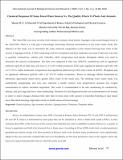Chemical Response Of Some Forest Water Sources Vs. The Quality Effects To Plants And Animals
Abstract/
The Taita Hills were once covered with extensive montane cloud forests. Ngangao is the second largest forest in
the Taita Hills. There is a wide gap in knowledge concerning chemical concentration in the water under study. The
objective of this study was to determine the water chemical composition of the streams flowing from some of the
sources at Ngangao forests. A CRD comprising with five treatments and three replicates was used. Probeware was used
to quantify conductivity, salinity, pH, Turbidity, DOC, temperature and nitrate. Phosphate tablate was used to
determine the amount of phosphate. The data were subjected to One way ANOVA. conductivity had no significant
difference (p˃0.05) in both cases. pH. had a C.V 0.15% within treatments. DOC had a significant difference (p<0.05) with
a CV 3.55 % within treatments. Temperature had significant difference (p<0.05) with a mean of 22.590C. Phosphate had
no significant difference (p˃0.05) with a CV 47.11% within treatments. Rivers or drainage ditches dominated by
subsurface agricultural return flows greatly affect water in the study area. The drinking water under study was
aesthetically unappealing, and may also represent a health concern. Less temperatures assumes less oxygen
concentration to reduce microbial respiration. The water is recommended to be safe considering its conductivity,
salinity, and pH range that has a close relationship. Therefore it’s that Regional boards are recommended to be formed
in order to detect changes chemical time after time in these areas with concern to microbial breeding in near future
since, Microbial breeding might affect much on health status of human beings.
Collections
- Department of Botany [232]

